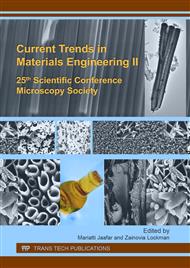p.206
p.211
p.215
p.220
p.224
p.228
p.232
p.236
p.240
Anodic ZrO2 Nanotube Arrays Formation by Anodisation in Ethylene Glycol with Varying Amount of Water
Abstract:
Anodisation of zirconium, Zr at 40 V for 60 min in 0.1 wt.% NH4F/ethylene glycol (EG) added to it 1 ml, 2 ml or 3 ml of water resulted in the formation of self-aligned ZrO2 nanotube (ZNT) arrays. Water content did not affect the length and diameter of the ZNTs but was influencing surface etching whereby better surface etching was observed for sample anodised in 3 ml-water/NH4F/EG. From transmission electron microcopy (TEM) image, the ZNTs were found to have an outer diameter of ~ 40 nm and wall thickness of 10 nm. Annealing at 400 °C was resulted in monoclinic (M-ZrO2) and tetragonal (T-ZrO2) formation, but at 600 °C M-ZrO2 dominates. Cr(VI) reduction is higher for ZNTs annealed at 400 °C compared to 600 °C sample.
Info:
Periodical:
Pages:
224-227
Citation:
Online since:
September 2017
Keywords:
Price:
Сopyright:
© 2017 Trans Tech Publications Ltd. All Rights Reserved
Share:
Citation:


